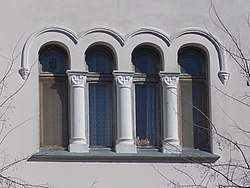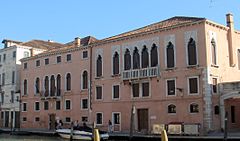Quadrifora
Quadrifora is a type of four-light window. It appears in towers and belfrys on top floors, where it is necessary to lighten the structure with wider openings. The quadrifora can also be a group closely set windows.[1]

Overview
The quadrifora is divided vertically in four parts by three small columns or pilasters, on which four arches rest, round or pointed.[2] Sometimes, the quadrifora is framed by a further larger arch; the space among the arches may be decorated by a coat of arms or a small circular opening.[3]
Less popular than the bifora or trifora, the quadrifora was nevertheless used in the Romanesque, Gothic, and Renaissance periods. In the 19th century, it came back in vogue in the period of eclecticism and the revival of old styles. Compared to the trifora, the quadrifora was generally used for larger and more ornate openings.
Gallery
 Quadrifora and trifora of the Palazzo del Comune in Piacenza
Quadrifora and trifora of the Palazzo del Comune in Piacenza Szent István University, Budapest
Szent István University, Budapest Reglerkirche in Erfurt, Germany
Reglerkirche in Erfurt, Germany Church Madonna dell’Orto, Venice
Church Madonna dell’Orto, Venice.jpg) Palazzo Nani, Venice
Palazzo Nani, Venice Palazzo Testa, Venice
Palazzo Testa, Venice
References
- Bollettino (in Italian). the University of California. 1969. p. 359. Retrieved 23 July 2019.
- Oppenheimer, Michael (2002). The Monuments of Italy: Central Italy (pt.1) : the regions of Toscana and Umbria. Tauris. p. 147. ISBN 9781860645709. Retrieved 23 July 2019.
- Chiese d'Etiopia. Il Monastero di Narga Sellase. Ediz. inglese. Random House Incorporated. 1999. p. 131. ISBN 9788881185290. Retrieved 23 July 2019.